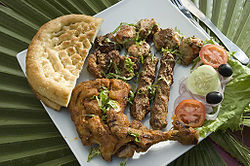 Gajar ka halwa | |
| Alternative names | Gajar ka Meetha Pak, gajrela, gajorer halwa gazoror halwa, carrot halwa, Gajar Pak |
|---|---|
| Course | Dessert |
| Region or state | South Asia |
| Associated cuisine | India, Bangladesh, Pakistan |
| Serving temperature | Hot or cold |
| Main ingredients | Carrots, milk, water, ghee, sugar, khoya |
| Variations | Black carrot halwa, red carrot halwa, carrot and beetroot halwa, cheesy carrot halwa |
Gajar ka halwa, also known as gajorer halwa, gajarno halwo, gajrela, gajar pak, and carrot pudding, [1] [2] [3] [4] is a sweet Indian dessert made by placing grated carrots in a pot containing a specific amount of water, milk, sugar, and cardamom and then cooking with ghee while stirring regularly. It is often served with a garnish of almonds and pistachios.[ citation needed ] The nuts and other items used are first sautéed in ghee, a type of clarified butter from the Indian subcontinent. [5] It is generally served hot during the winter. [6]
Contents
The dessert is traditionally eaten during all of the festivals in the Indian subcontinent, mainly on the occasion of Diwali, [7] Holi, Raksha Bandhan, and Eid. [8] It is served hot during the winter. [9]


